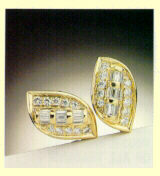
 |
IN THE BEGINNING...
Getting to know about diamonds is like taking an armchair tour of some of the world's most exciting places. Today the tour can spin you to such faraway cities as London, Hong Kong, Antwerp, Tel Aviv and Mnshasa; in each a new dimension is added to diamond's story.
But it all began in India.
Jean Baptiste Tavernier, a plump, jolly Frenchman, favored exotic clothes and travel to exotic places. He was born in Paris in 1605, apprenticed to a jeweler in his youth and, at age 22, set out to
become the Charles Kuralt of his day, with a dash of Marco Polo thrown in.
One of his major achievements was to bring back from India a gemstone that was to become a marvel in the decoration of French royalty and nobility-the diamond.
Virtually nothing is known of early Indian diamond mining other than that it was centered between the modern cities of Hyderabad and Anantapur, about 350 miles southwest of Bombay, the present Indian "diamond capital." The most famous mine was the Golconda.
Mining was well established by
the mid 17th century. In a single
mine, Tavernier reported, there
were "about 60,000 persons at
work, men, women and children,
the men being employed to dig, the women and children to carry the earth."
Indian royalty of the day relished these gemstone riches. Again, Tavernier: "When the king seats himself upon his throne, there is a transparent jewel with a diamond appendant of 80 or 90 carats encompassed with rubies and emeralds so hung that
it is always in his eye. Upon each
side of the throne are two parasols, the handles covered with diamonds. This is the [Peacock]
throne which Tamerlane began
 and Cha-Jehan finished. It is reported to have cost 160 million
Livres. Behind this is a tub where
the king bathes, the outside
whereof shines all over with diamonds."
India's primacy in diamond
production lasted until the 1720s
when diamonds were discovered
in Brazil in the state of Minas Gerais -later to become famous as
one of the most gem-rich locations in the world.
and Cha-Jehan finished. It is reported to have cost 160 million
Livres. Behind this is a tub where
the king bathes, the outside
whereof shines all over with diamonds."
India's primacy in diamond
production lasted until the 1720s
when diamonds were discovered
in Brazil in the state of Minas Gerais -later to become famous as
one of the most gem-rich locations in the world.
A Portuguese soldier of fortune, Bernardo da Fonesco Lobo, is credited with the original find. He'd gone to Brazil in search of gold but was intrigued by some pebbles he discovered when washing the sands of the Rio dos Marinhos. Lobo had served in India and thought his "pebbles" might be diamonds- something later confirmed by authorities in Lisbon.
The Minas Gerais discovery was followed by a number of finds in other states, the biggest in Bahia in 1844. In the following 20 years, production peaked and then declined rapidly. But the Portuguese Crown had by then taken full advantage of the diamond yields. Soon after Lobo's first strike, the Crown kicked out all Brazilian gold miners and handed over the diamond concessions to a few favorites, who built a huge slave labor force to work the mines. For this generosity to the mine owners, the Portuguese monarchs were suitably rewarded -in diamonds. The Brazilian stones were of good quality and the country produced some 16 million carats between about 1750 and 1850. But they could not shake off the stigma that they were inferior to Indian stones.
The outcome: enterprising dealers, many of them Dutch, shipped Brazilian diamonds to Goa on India's west coast and then sold them locally as Indian goods.